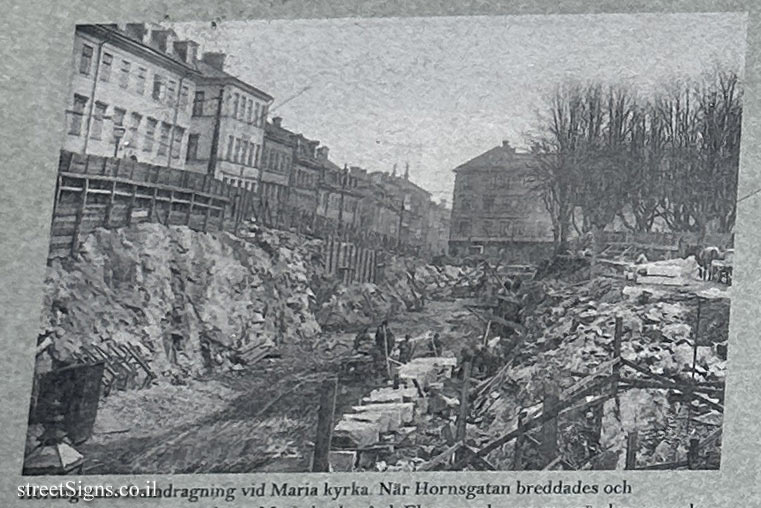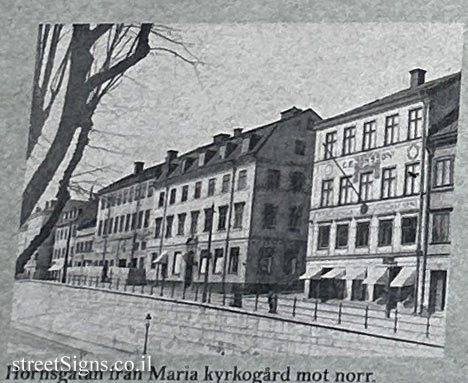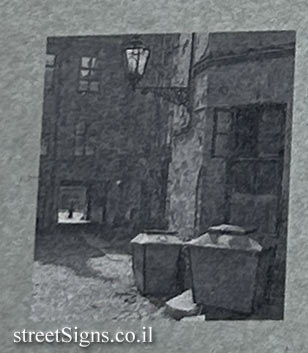The sign describes the history of the street where the sign is located (next to the "Boat of Fools" statue
 Click for sign's details
Click for sign's details)
One of a series of signs describing streets in the city of Stockholm
The pictures that appear on the sign are shown here enlarged, with the translation of the text below (the pictures are numbered from top to bottom and left to right)
(1) The extension of Hornsgatan by Maria kyrka. When Hornsgatan was widened and sunk, a piece of Maria’s cemetery disappeared. Several old graves were dug up and moved. Many houses were demolished, e.g. a. Daurerska malmgården, Bellman’s birthplace. The cemetery was completed in 1904
 Click for a larger image
Click for a larger image (2) Hornsgatan looking east in 1901. The houses on the right are newly built along the new street line. On the right in the background is Maria’s poorhouse, which was demolished shortly afterwards. In 1904, the new trail was completed with retaining walls and stairs at the cut-off Bellmansgatan.
 Click for a larger image
Click for a larger image (3) Hornsgatan from Maria cemetery to the north. In the corner by Maria trappgränd is a cafe and in the house on the right is C E Jonsson’s Möbleringestablissement
 Click for a larger image
Click for a larger image (4) The farm to Hornsgatan 48 in 1965.
 Click for a larger image
Click for a larger image [Credit]
(1) (2) Photographs in the Stockholm City Museum
(3) Photo LARSSON ATELIER 1907
(4) FOLO GÖRAN FREDRIKSSON
Translation of the text on the sign:
[Translation of the text in Swedish]
Hornsgatan
HORNSGATAN AND Gõtgatan were the two main axes in the new street network that was laid out across Södermalm in the 1640s. Horn is a natural name and refers to the district’s westernmost headland that juts out into Årstaviken.
In the great Maria fire of 1759, the church and all the wooden houses on the mountain burned. Many of the stone houses survived so well that they could be completely or partially rebuilt.
Today we call the Hornsgatspuckeln the high part of the street. It is the old stretch of street, which remained when the street was blown down and widened at the beginning of the 20th century.
In 1964, the Real Estate Board adopted a remediation plan that required the demolition of almost all the houses on Hornsgatspuckeln. The building was considered uninteresting and in too bad a condition for it to be possible to equip it. But opinion grew against the decision. Many believed that it was quite possible to create a neighborhood where people would want to live, where they only saw dirt and decay. This is what author Per Anders Fogelström wrote in 1965.
»When walking through the streets: let your imagination play, try to imagine what it could look like here if the houses were carefully renovated, plastered in bright colors. If the small town became inhabited, the houses lived, children played on the merry, car-free cobblestone slopes, scrap and rubbish disappeared and trees grew green. The fairy tale could become reality.
Mariaberget one of the city’s finest residential areas and at the same time a preserved idyll, a living work of art. Can be - if we want enough, if we manage to convince enough people.«
After several years of investigations, debate and opinion formation, while the houses fell into disrepair and were increasingly neglected, it was agreed that Mariaberget’s buildings were interesting and worth preserving. Today, Östra Mariaberget is a unique 18th-century environment and one of Stockholm’s most attractive residential areas.
The settlement on Mariaberget constitutes a so-called RESERVE AREA. Such include a number of properties in a preserved cultural-historically valuable area as examples of remains of the old city. The houses are owned and managed by AB Stadsholmen, a subsidiary of AB Svenska Bostäder
The settlement on Mariaberget constitutes a so-called RESERVATION SUMMER ADE. Such include a number of properties in a preserved cultural-historically valuable area as examples of remains of the old city. The houses are owned and managed by AB Stadsholmen, a subsidiary of AB Svenska Bostäder

 Click for sign's details)
Click for sign's details)  Click for a larger image
Click for a larger image  Click for a larger image
Click for a larger image  Click for a larger image
Click for a larger image  Click for a larger image
Click for a larger image